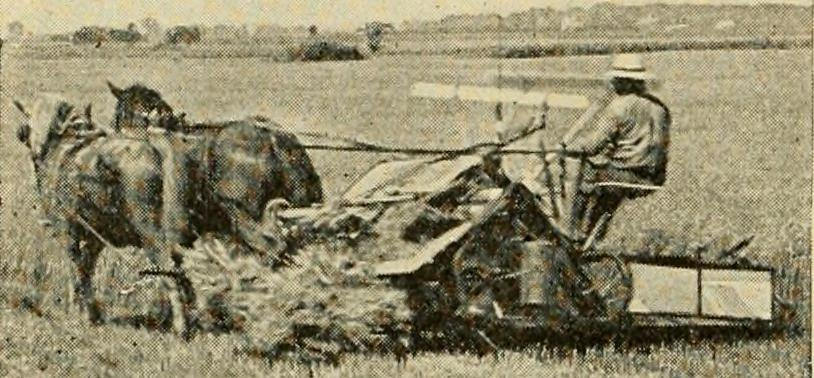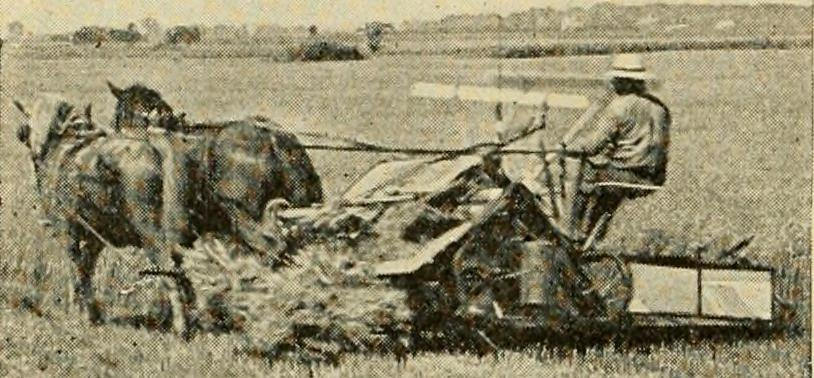

(Continued from Part 1. This concludes the article.)
Planting
A good old-fashioned seed broadcaster maybe a good device to put back as well. The good news is they still manufacture these. I use mine in the mid-Spring to seed my hay field. I use a technique an old timer passed down to me. The method requires no tilling of the dirt. Just broadcast the seed right before it rains. When it rains, the seed will be transported into the “duff” or layer of decaying materials, where it should spout. I did this and had decent results. Another variation of this method was to broadcast the seed on a very dewy morning. Many of us may garden now but when commercial food production is non-existent, our gardening will need to expand to ensure we have food to last until the next harvest. A wheeled seeder will make quick work of planting many seeds and the saved time can be used for other important tasks. I normally plant my direct sow seeds individually by hand but post-TEOTWAWKI I will definitely be using the wheeled planter.
Ground-driven
I originally was not going to get into haying, but I saw an opportunity to buy some used haying equipment cheaply. My tractor is on the smaller side so it will not run many of the newer power-take-off (PTO) driven implements. Instead, I bought a ground drive rake and Tedder that is powered by the wheels turning that in turn moves a chain to turn the rake and Tedder. Some would buy these pieces of equipment, manufactured long before I was born, as antiques but they will be operable in the post-TEOTWAWKI world. The Amish still use ground drive technology and have even offered to buy mine since these implements are getting harder to find. If the tractor can no longer operate, the ground drive equipment can be powered by oxen or horses.
Harvesting
We have a couple old scythes that we can cut hay with or if we can use to cut grains like wheat or oats with. We even have extra handles put aside. Once a year we take them out and use them for a half hour or so. I have been studying the old art of making a haystack since we will not be putting our hay into hay bales post-TEOTWAWKI. Using a scythe takes some coordination and of course muscle. We also have some hand-held corn cutters for taking down stalks of corn, as well as, hand cranked corn-shellers that quickly and efficiently take the corn kernels off the cob. For out fruit trees we have a hand-held harvester that is a basket, made of wire, mounted on a long wood pole, that helps get the fruit high up in the trees.
Hourglasses
Many people no longer require hourglasses. Their usefulness has been relegated to a timer for board games. I recently picked up a vintage brass hourglass that wasn’t made in China. I timed the amount of time it took the grains of sand to empty several times. It took 3 minutes 15 seconds for it to empty so I assumed this was an old egg timer since it takes roughly 3 minutes to soft boil a chicken egg. The survival value in being able to measure the cook time of an egg is to help ensure the food is properly cooked thus limiting the possibility of contracting salmonella. An hourglass can also be used to time other processes as well.
The Ice House
Where we live there are a few different sects of Amish. Some are allowed to use propane fired refrigeration, others rely upon the use of ice. Unlike the ice houses of 100 plus years ago, the Amish have capitalized on the use of Styrofoam. I have not been inside an Amish ice house yet, but have seen several from the outside and talked to a few Amish about them. I have also studied their making via the internet. So, where do the Amish get their ice for their ice houses? One day, the wife and I stopped at one of the local Amish bulk food stores. Outside were four pallets of red, 5-gallon plastic buckets with more scattered around their lawn. I asked if they were selling the buckets and they said “no” they were for making ice for ice houses. I talk to them about how they did it and they giggled and said they just put the buckets outside and let them fill up with rain water and then let them freeze, then get them out and stack them in the ice house. From talking with them their stored ice will last until the next winter. So, now we have another use for all those empty 5-gallon food buckets after TEOTWAWKI.
Kitchen Utensils and the like
There is no doubt that modern conveniences have drastically lessened the time for meal preparation. While today meal preparation ranges from 20 minutes to about an hour our foremothers were not so lucky. Eating is one of the basic survival tasks that we all must accomplish, but today most people don’t even consider it a “survival” task. Many of the kitchen utensils that our grandmothers used have been pretty much replaced with gadgets with electric motors. Blenders, food processors, electric coffee pots, toasters, have helped save time in the kitchen. I have been to homes that don’t even have a simple potato masher, since the people use instant potatoes. Many of the mixing spoons and spatulas are now made of cheap plastic and are from China. Good quality kitchen knives, that keep a good sharp edge, are no longer needed since food bought at the Piggly Wiggly is often already cut and cooked and just needs heated up in the microwave. We need to realize that, in the post-TEOTWAWKI world, we are all going to revert back to being our own butcher, baker and candle stick maker. Good quality knives will make our work both safer and quicker. Hand cranked meat grinders and food choppers will also save on time.
One of the assumptions, that I have made about post-TEOTWAWKI life, is that we will be needing larger pots and pans. Why? First, the preservation of the harvest will be much easier. This past Fall I spent a lot of energy and effort in preserving sweet corn. If I had had larger stock pots, I could have processed the corn much faster and saved on propane as well. I have picked up several large commercial grade pots and pans from the Salvation Army for next harvest season and for our post end of the world kitchen that will probably be feeding more than four people. When I go to auctions and second-hand stores, I am always looking for usable crocks. These will be used for brining, fermenting and storing things like meat, kraut and vinegar. Besides utensils I have been stocking up on packages of cheese cloth and 100% cotton muslin cloth for various task such as pressing apples. Since paper towels will be quickly used up, I have also stocked up on 100% cotton flour sack kitchen towels that can be washed and reused.
Tubs and Basins
Another item I do not recall being discussed in the Prepper world in having tubs and basins stored away. The good news is that most people do not see the utility in the old galvanized tubs anymore. In many instances their usefulness has been relegated to being a decorative plant holder so they are normally cheap on the second-hand market. In the late 1800s and early 1900s the old galvanized tub was the world’s washing machine and in many cases their bathtub too. Keeping things clean will help in cutting down on disease and in the case of clothes may prolong their life. I have a few ceramic wash basins and pitchers to use for personal hygiene in the post-electric world much like people used in the past.
Cogs, Sprockets, Bearings, Pulleys and Belts . . . oh my.
We all use mechanical advantage in our everyday lives, but for the most part, we never give it much thought. We purchase our tools and devices with the calculations and parts already figured out and put together. At some point, in the post-electric world, people will need to hobble together machinery to help perform simple tasks. I will go out on a limb and say that most people, probably do not have an on-hand supply of cogs, sprockets, bearings, pulleys, and various belts. When I look at and study the tools and devices of yester years, I conclude that the simple cog and a handle to move a cog is the most under valued inventions that are still used today. When I look at my ground drive hay equipment, I see sprockets and cog and roller chain. When I look at my corn shellers, I see a series of cogs moved by a simple hand crank. Even the simple old hand-cranked mixer uses cog and a hand crank. It would be very advantageous to learn about the various aspects of mechanical advantage and the various configurations that turn regular human strength into industrial strength.
The Humble Treadle
Most of use do not pay much attention to the value of the treadle. Watching a movie, we see a woman spinning wool using a spinning wheel, we may watch another movie and see a man sharpening an axe with an old sandstone fashioned to a bench and powered by the simple push of a foot. And let us not forget the treadle showing machine which was all the rage in a bygone era. The humble treadle provided power to many simple machines throughout the ages, and will enjoy a massive resurgence when the lights go out for good.
There are many, long forgotten, pieces of technology whose usefulness have been marginalized to relics in a museum or antique shop. As Preppers, we need to recognize that these old devices play a vital role in our TEOTWAWKI future. There usefulness is not just the task that they help do, but rather sharing the long-lost art of simple old technology. Google will not be around to ask what type of gear ratio or “V” belt you need in your post-electric world so learn as much as you can now.



